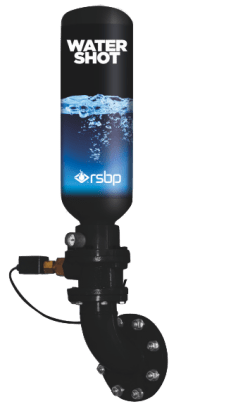Explosion suppression systems are special technical devices which prevent the development of destructive maximum pressure by quickly introducing extinguishing agents. When an explosion is suppressed, explosion products do not spread outside the equipment or the protected area. As a result, structural integrity is not compromised and people are not harmed.
Automatic explosion suppression systems are installed in hazardous areas in accordance with the European explosion protection standard EN 1127-1. They consist of detection elements and dampers. Special sensors respond to an increase in temperature and pressure of a combustible dust/air mixture, transmit a signal to the control centre, which then initiates the injection of an explosive suppressant.
The dampers are easy to replace after use.
How Does Explosion Suppression Work?
This system is designed to detect and stop explosions in their tracks, acting swiftly to protect your facility from severe damage. Here’s a simple breakdown of how it works:
When the system’s sensors identify the signs of a potential explosion, they send an alert to the control panel. The control panel, acting as the brain of the operation, then triggers the release of a suppression agent – a substance like chemicals or inert gases – into the affected area. This rapid reaction effectively dampens the flames, preventing an explosion from occurring and thus causing widespread destruction. It’s a precise and quick process that ensures the safety of your facility, employees, and assets.
Components of the Explosion Suppression System
Let’s take a closer look at the key components of an explosion suppression system:
-
Sensors and Detectors: These advanced sensors continually monitor the environment for any signs of a potential explosion. Their quick response time is crucial for initiating the suppression process promptly.
-
Control Panel: Acting as the central command center, the control panel processes information from the sensors and triggers the release of the suppression agent when needed.
-
Suppression Agent Containers: These containers hold the suppression agents, ready to be deployed as soon as an alert is received. Whether it’s a chemical compound or inert gas, the choice of suppression agent is tailored to the specific needs of the facility.
Advantages of an Explosion Suppression System
Investing in an explosion suppression system offers several key advantages:
-
Swift Response: The system’s real-time detection and quick action eliminate the possibility of explosion, reducing potential damages and risks.
-
Asset Protection: By neutralizing explosions early on, the system protects critical infrastructure, machinery, and valuable assets from extensive damage.
-
Enhanced Workplace Safety: Prioritizing the well-being of personnel, an explosion suppression system contributes to creating a safer working environment, instilling confidence among employees.
-
Regulatory Compliance: Implementing an explosion suppression system ensures that your facility aligns with industry standards, providing peace of mind and mitigating regulatory risks.
Elevate your safety standards with an explosion suppression system. Embrace a proactive approach to industrial safety, safeguarding your facility and personnel from potential disasters. Contact us today to explore how this innovative system can be seamlessly integrated into your operations. Stay secure, stay ahead!
ATEX.CENTER Industrial Dust Explosion Protection across various industries, ensuring safety and continuity. From Explosion protection for energy production facilities and Explosion protection for chemical and pharmaceutical production, for Explosion protection for foodstuffs, Explosion protection for metalworking industries, Explosion protection for wood processing plants, and agricultural sectors, our expertise secures your operations against potential hazards, guaranteeing peace of mind and uninterrupted productivity.

